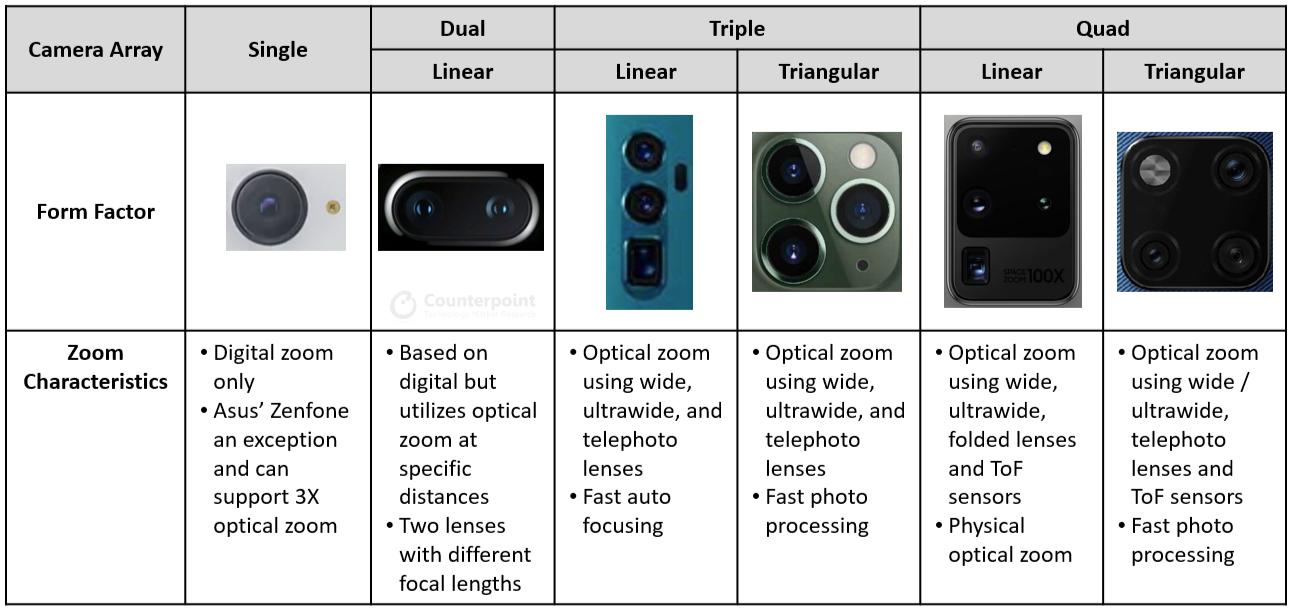Samsung’s recently launched Galaxy S20 series reveals several key camera trends we are likely to see for premium smartphones this year. They include large image sensors, powerful optical zoom functionality, 108MP sensors and advanced camera array setups.
Big on image sensors
Image sensors are semiconductors that convert light coming through a lens to a digital signal. These sensors are the major element determining an image’s quality and the number of pixels. Hence, the image sensor’s size is critical to how much detail can be captured from a given shot.
The Galaxy S20 Ultra has a 1/1.33-inch image sensor, larger than in some compact DSLRs (typically 1/2.00-inch – 1/1.70-inch), and we expect competition here to intensify. In the short term, Chinese brands like Huawei, Xiaomi, and OPPO will continue to introduce larger sensors. Huawei P40 Pro Plus already has a 1/1.28-inch sensor but is not available outside of China.
Image sensor size – a rising trend

Hybrid optical the emerging battlefield in zoom
Digital zoom has typically been used in smartphones to enlarge images, but a major issue has been image loss. To overcome this, optical zoom features have increasingly been introduced since 2016 which utilizes multiple lenses. The Galaxy S20 is Samsung’s culmination of these efforts, and its 103mm telephoto lens now rivals those found in DSLRs (100mm-300mm).
Optical zoom by key flagship model

The Galaxy S20 Ultra uses a combination of multiple lenses (referred to as a folded or ‘periscope’ lens) to offer 4X optical zoom, then deploys a “hybrid-optic” 5X-10X zoom function with lossless image by using a combination of sensor cropping and binning technology along with AI multi-frame processing. We recently put the Galaxy S20 Ultra’s cameras through the paces and results are impressive.
This year, we expect competition in high-resolution optical or hybrid optical zoom with lossless image to intensify, with broad adoption of periscope lenses across many flagship models. To enhance lossless zoom, we also expect OEMs to continue with multiple (four to five) sensor implementations.
Linear camera lens array setup
A camera’s lens setup has a significant impact on overall smartphone design. There are various array setups including circular, square, triangle, and linear, with the latter two being most common.
Main camera lens array setups

Triangle arrays enable quicker image processing as each lens is equidistant to the subject, requiring less processing as the camera switches from lens to lens. Linear arrays provide faster auto-focusing functions by distance measurement based on the difference of images captured by two or more lenses.
With the increasing adoption of ‘periscope lenses’ in premium devices, we expect linear arrays to dominate as they are necessary components of the periscope-based camera platform.
Rising camera module BOM costs
With the camera being one of the most competitive elements of premium smartphones, camera component costs have been rising continuously and we expect its share of BOM to increase in 2020. The Galaxy S20 Ultra has one of the costliest camera setups in a smartphone. It accounts for 21% of the total BOM, after the system-on-chip (Snapdragon 865 or Exynos 990) along with the 5G (X55 5G or Exynos 5G 5123) baseband.
The ability of an OEM to control production costs for camera modules will play a critical role in securing competitive advantage, especially in the 2020 environment where consumer price sensitivity is likely to be higher than normal.
Ratio of camera modules costs within the smartphone BOM continues to rise

Hybrid Optical Zoom to See a Wider Adoption
2020 started with the Galaxy S20 series offering hybrid optical zoom capabilities, and the same can be expected with the flagship Galaxy Note series later this year. The feature could also make its way to some A-series smartphones. Besides Samsung, Huawei with its P40 Pro series and Oppo with Find X2 Pro has also introduced hybrid zoom feature. We are expecting more OEMs to embrace a periscope style lens to include hybrid optical zoom capabilities on the upcoming premium smartphones.

